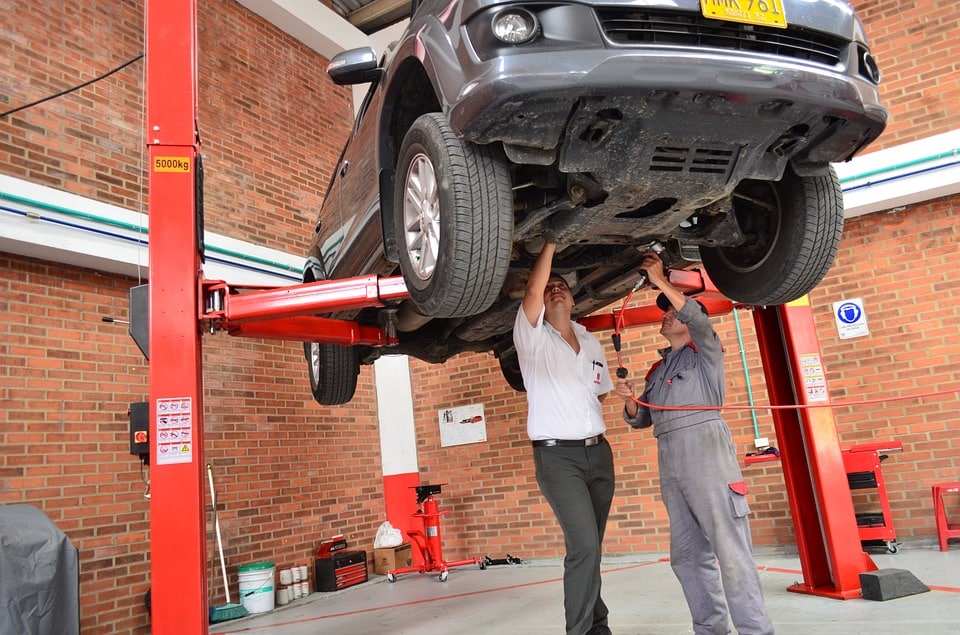How to Talk About Car Parts in Spanish

Knowing how to say car parts in Spanish is one of those things you don’t know you need until you need it. Rather than learn the hard way, why not add some key words and phrases to your vocabulary for future use?
Here I’ll share the Spanish words and translations for 40 different car parts, plus helpful phrases and sample dialogues for talking about cars. That way, if you have car trouble while abroad, at least you’ll be able to talk about it.
Download: This blog post is available as a convenient and portable PDF that you can take anywhere. Click here to get a copy. (Download)
Spanish Words for Car
Before we learn the Spanish words for different car parts, let’s look at how to say “car” in Spanish.
The most commonly used word for “car” varies by country or region, but all Spanish speakers will understand you if you use any of these words.
| Word for "car" | Countries where it's used |
|---|---|
| carro | Most Latin American countries |
| coche | Spain, parts of Mexico and Argentina |
| auto | Some Latin American countries including Argentina, Chile and Uruguay |
| automóvil (automobile) | All countries, but only in formal contexts |
Car Parts in Spanish
While this list doesn’t include every single part of a car, I’ve selected the most important ones, or rather, the ones I consider you may need to use in case of an emergency or car-related situation in a Spanish-speaking country.
Car Interior
el asiento (the seat)
Este asiento es muy cómodo. (This seat is very comfortable.)
el cinturón / el cinturón de seguridad (the seatbelt)
Abróchate el cinturón. (Fasten your seatbelt.)
las alfombrillas / los tapetes (the vehicle mats)
Tuve que comprar alfombrillas nuevas para mi coche. (I had to buy new mats for my car.)
el volante (the steering wheel)
Coloque las manos en el volante. (Place your hands on the steering wheel.)
el acelerador (the gas pedal)
Su coche hacía un ruido extraño cada vez que pisaba el acelerador. (His car made a strange noise every time he put his foot on the gas pedal.)
el freno (the brake)
¿Cuál es el pedal del freno? (Which one is the pedal for the brake?)
el freno de mano (the handbrake / the parking brake)
Tire de la palanca hacia arriba para activar el freno de mano. (Pull the level up to apply the handbrake.)
la luz de freno (the brake light / the stop light)
La luz de freno se activa cuando se pisa el pedal de freno. (The brake light is activated when the brake pedal is pushed.)
el embrague (the clutch)
El embrague de mi auto está dañado. (The clutch in my car is damaged.)
la guantera (the glove compartment)
Los documentos están en la guantera. (The documents are in the glove compartment.)
la marcha (the gear)
No sé cómo cambiar de marcha. (I do not know how to change gear.)
el claxon / la bocina (the horn)
María tocó el claxon tres veces. (María sounded the horn three times.)
la visera (the sunshield)
Baja la visera, por favor. (Pull down the sunshield, please.)
el salpicadero (the dashboard)
He olvidado mi teléfono en el salpicadero del coche. (I have forgotten my phone on the dashboard.)
el espejo retrovisor (the rearview mirror)
Ajusta tu retrovisor para tener una visibilidad máxima. (Adjust your rearview mirror for maximum visibility.)
el conductor / la conductora , el / la chófer (the driver)
El conductor del vehículo falleció en el accidente. (The driver of the vehicle died in the accident.)
Car Exterior
el parabrisas (the windshield)
El parabrisas se rompió en pedazos. (The windshield shattered into pieces.)
el limpiaparabrisas (the windshield wiper)
Necesito cambiar los limpiaparabrisas. (I need to have the windshield wipers replaced.)
la ventanilla del auto (the car window)
¿Puedo bajar la ventanilla? (Can I roll down the window?)
la llanta (AmL) / la rueda (ES) / el neumático (the tire)
¿Monta neumáticos nuevos? (Do you fit new tires?)
la rueda de repuesto (ES) / la rueda de auxilio (AR) / la rueda de refacción (MX) / la llanta de repuesto (the spare tire)
¿Tiene alguna llanta de repuesto? (Do you have any spare tire?)
el parachoques / el paragolpes (the bumper)
Este vehículo incluye sensores de aceleración en el parachoques. (This vehicle includes acceleration sensors in the bumper.)
las luces del coche / los faros del coche (the car lights)
las luces delanteras / los faros delanteros (the front lights / the headlamps)
las luces traseras / los faros traseros (the rear lights / the taillights)
Este carro posee tres luces traseras. (This car has three taillights.)
las luces antiniebla / los faros antiniebla (the fog lamps / fog lights)
la luz direccional / el intermitente (the turn signal / the blinker)
Oirá clics mientras el intermitente esté encendido. (You will hear clicks while the turn signal is on.)
el capó (the hood)
El motor está bajo el capó. (The engine is under the hood.)
el maletero / la cajuela (MX) (the trunk)
Había un maleta rosa en el maletero. (There was a pink suitcase in the trunk.)
el tubo / caño de escape (the tailpipe)
Deberíamos controlar las emisiones del tubo de escape. (We should control the tailpipe emissions.)
las manijas de las puertas (the door handles)
Las manijas de las puertas del coche se han desgastado y necesitan ser reemplazadas. (The car door handles have worn out and need to be replaced.)
Mechanical Parts of a Car
el motor (the engine)
El compresor está conectado al motor del coche. (The compressor is connected to the engine of the car.)
la caja de cambios (the gearbox / the transmission)
La caja de cambios está colocada sobre tacos de goma. (The transmission is mounted on rubber pads.)
la válvula (the valve)
¿Para qué sirven las válvulas en un carro? (What is the use of valves in a car?)
el cigüeñal (the crankshaft)
No logro localizar el sensor de posición del cigüeñal. (I cannot find the crankshaft position sensor.)
la suspensión (the suspension)
La suspensión del auto no funciona correctamente. (The car suspension does not work properly.)
la batería (the battery)
¿Cuánto se tarda en cargar la batería de un coche? (How long does it take to charge a car battery?)
la bomba de agua (the water pump)
El mecánico dice que el problema está en la bomba del agua. (The mechanic says the problem is in the water pump.)
la bujía (the spark plug)
Deberías limpiar las bujías. (You should clean the spark plugs.)
el tanque / depósito de combustible / gasolina (the gas tank)
Tenemos que llenar el tanque de gasolina antes de marcharnos. (We have to fill up the gas tank before we go.)
Spanish Phrases to Talk About Car Problems
Mi carro ha tenido una avería. (My car has had a breakdown.)
El / La…no funciona. (The…is not working.)
Necesito… (I need…)
¿Hay alguien que pueda ayudarme, por favor? (Can anyone help me, please?)
¿Hay un taller de coches por aquí? (Is there any car workshop near here?)
¿Dónde está el taller de coches más cercano? (Where is the closest car workshop?)
Se me ha pinchado / vaciado una rueda. (I have a flat tire.)
Me he quedado sin gasolina. / Se me ha acabado la gasolina. (I have run out of gas.)
El coche no arranca. (ES) / El carro no prende. (AmL) (The car will not start.)
La batería está muerta / vacía. (The battery is flat / dead / empty.)
Necesito una grúa. (I need a wrecker.)
El / La…hace un ruido extraño. (The…is making a strange noise.)
Sample Dialogues About Cars
At the car rental agency
Dependiente (Clerk): Buenos días, ¿en qué puedo ayudarle? (Good morning, may I help you?)
John Doe: Quisiera alquilar un auto. (I would like to rent a car.)
Dependiente: Fantástico. ¿Qué tipo de auto anda buscando? (Great. What kind of car are you looking for?)
John Doe: ¿Tienen compactos? (Do you have a compact?)
Dependiente: Por supuesto. La cuota es 60 dólares al día. Si desea seguro completo, serían 10 dólares adicionales. (But of course! The rate is 60 dollars per day. If you want full coverage insurance, that would be 10 more dollars.)
John Doe: ¿Hay límite de millaje? (Is there a mileage limit?)
Dependiente: No. Todos nuestros autos tienen millaje ilimitado. (No, there is not. All our cars have unlimited mileage.)
John Doe: Perfecto. Entonces elijo el compacto azul. Lo necesitaré por tres días. (Perfect. Then I choose the blue compact. I will need it for three days.)
Dependiente: ¿Puedo ver su licencia para manejar? (May I see your driver’s license?)
John Doe: Claro, no hay problema. Aquí tiene. (Sure, no problem. Here you are.)
Dependiente: Gracias. Por favor, rellene este formulario. (Thank you. Please, fill in this form.)
At the car workshop
Mecánico (Mechanic): ¿Cuál es el problema? (What seems to be the problem?)
Jan Doe: El carro está haciendo un ruido extraño. (The car is making a strange noise.)
Mecánico: ¿Ha podido localizar el ruido? (Have you been able to locate the noise?)
Jan Doe: Parece que viene del motor, pero no estoy seguro. (It seems to come from the engine, but I am not sure.)
Mecánico: Echémosle un vistazo. ¿Puede prender el carro y abrir el capó, por favor? (Let’s have a look. Could you please start the engine and pop the hood?)
Jan Doe: Sí, claro. Enseguida. (Sure, right away.)
Mecánico: Hmm… No se oye ningún ruido. ¿Está seguro de que viene del motor? (Hmm…I cannot hear anything. Are you sure it was coming from the engine?)
Jan Doe: Estoy bastante seguro. Cuanto más rápido manejaba, más fuerte era el ruido. (Pretty sure. The faster I was driving, the louder the noise was.)
Mecánico: Entiendo. Parece que el carburador está mal ajustado. (I see. It seems that the carburetor is not adjusted correctly.)
Jan Doe: ¿Eso es todo? (Is that all?)
Mecánico: Veo que hay una fuga de líquido refrigerante. ¿Puedo echar un vistazo debajo del auto? (I see there is a coolant leak. Can I have a look under the car?)
Jan Doe: Sí, no hay problema. (Sure, no problem.)
Mecánico: ¡Bingo! He encontrado el problema. El mofle está suelto. (Bingo! I have found the problem. The muffler is loose.)
Now you have a solid vocabulary bank for car parts, as well as some phrases and sample dialogues to prepare you for conversations about cars.
Whether you’re living abroad or planning your next trip, these are sure to come in handy whenever you’re behind the wheel (or on the side of the road in a broken-down bus).
Happy travels, and drive safe!
Download: This blog post is available as a convenient and portable PDF that you can take anywhere. Click here to get a copy. (Download)










